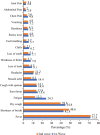Clinical profile of hospitalized COVID-19 patients in first & second wave of the pandemic: Insights from an Indian registry based observational study
- PMID: 34259194
- PMCID: PMC8555588
- DOI: 10.4103/ijmr.ijmr_1628_21
Clinical profile of hospitalized COVID-19 patients in first & second wave of the pandemic: Insights from an Indian registry based observational study
Abstract
Background & objectives: India witnessed a massive second surge of COVID-19 cases since March 2021 after a period of decline from September 2020. Data collected under the National Clinical Registry for COVID-19 (NCRC) were analysed to describe the differences in demographic and clinical features of COVID-19 patients recruited during these two successive waves.
Methods: The NCRC, launched in September 2020, is an ongoing multicentre observational initiative, which provided the platform for the current investigation. Demographic, clinical, treatment and outcome data of hospitalized, confirmed COVID-19 patients were captured in an electronic data portal from 41 hospitals across India. Patients enrolled during September 1, 2020 to January 31, 2021 and February 1 to May 11, 2021 constituted participants of the two successive waves, respectively.
Results: As on May 11, 2021, 18961 individuals were recruited in the registry, 12059 and 6903 reflecting in-patients from the first and second waves, respectively. Mean age of the patients was significantly lower in the second wave [48.7 (18.1) yr vs. 50.7 (18.0) yr, P<0.001] with higher proportion of patients in the younger age group intervals of <20, and 20-39 yr. Approximately 70 per cent of the admitted patients were ≥ 40 yr of age in both waves of the pandemic. The proportion of males were slightly lower in second wave as compared to the first [4400 (63.7%) vs. 7886 (65.4%), P=0.02]. Commonest presenting symptom was fever in both waves. In the second wave, a significantly higher proportion [2625 (48.6%) vs. 4420 (42.8%), P<0.003] complained of shortness of breath, developed ARDS [422(13%) vs. 880 (7.9%), P<0.001], required supplemental oxygen [1637 (50.3%) vs. 4771 (42.7%), P<0.001], and mechanical ventilation [260 (15.9%) vs. 530 (11.1%), P<0.001]. Mortality also significantly increased in the second wave [OR: 1.35 (95% CI: 1.19, 1.52)] in all age groups except in <20 yr.
Interpretation & conclusions: The second wave of COVID-19 in India was slightly different in presentation than the first wave, with a younger demography, lesser comorbidities, and presentation with breathlessness in greater frequency.
Keywords: Complication; National Clinical Registry for COVID-19; outcome; pandemic waves; symptom.
Conflict of interest statement
None
Figures



Comment in
-
Broadening the scope of nation-wide clinical registry for hospitalized COVID-19 patients.Indian J Med Res. 2021 May;153(5&6):696-697. doi: 10.4103/ijmr.ijmr_2170_21. Indian J Med Res. 2021. PMID: 34643569 Free PMC article. No abstract available.
-
Author's response.Indian J Med Res. 2021 May;153(5&6):697-698. doi: 10.4103/0971-5916.327496. Indian J Med Res. 2021. PMID: 34643570 Free PMC article. No abstract available.
References
-
- Ministry of Health and Family Welfare |Home. [accessed on May 30, 2021]. Available from: https://www.mohfw.gov.in/
-
- India COVID: 27,369,093 Cases and 315,263 Deaths - Worldometer. [accessed on May 27, 2021]. Available from: https://www.worldometers.info/coronavirus/country/india/
-
- Ranjan R, Sharma A, Verma MK. Characterization of the second wave of COVID-19 in India. medRxiv. 2021 doi: https://doi.org/10.1101/2021.04.17.21255665.
Publication types
MeSH terms
LinkOut - more resources
Full Text Sources
Medical
Research Materials
